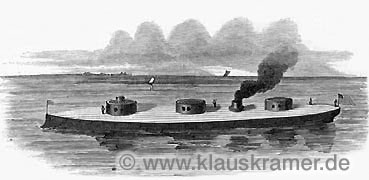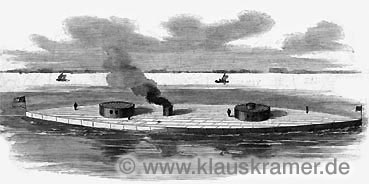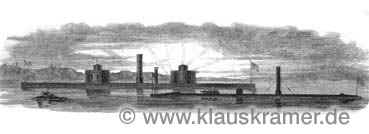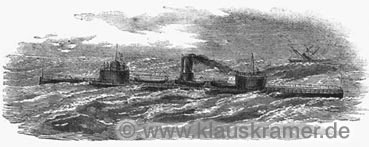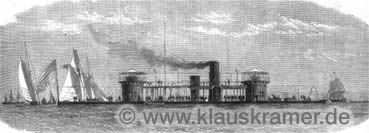
Sunken Confederate warship Virginia possibly found
By PAUL CLANCY, The Virginian-Pilot
© April 30, 2003
Last updated: 5:15 PM
 |
| Reece Young, left in photo above, and Eric Moore stand atop a boiler off Craney Island in March. The boiler may belong to the ironclad CSS Virginia, below. Photo by Steve Earley / The Virginian-Pilot.
|
| Special report: Raising the Monitor turret |
Or was it?
A recent underwater survey for APM Terminals Virginia, the company that hopes to build a new marine terminal on the Elizabeth River, describes two shipwrecks near the project and says there is ``a distinct possibility'' that they might be parts of the Virginia and a schooner that hit the submerged warship and sank next to it.
APM Terminals is a subsidiary of the giant Danish company that owns Maersk Sealand ship line.
Those associated with the possible discovery are cautious about drawing conclusions, but the idea that even parts of the ship might be found fires their historic cannons.
``It probably wasn't completely salvaged,'' said John Broadwater, manager of the National Oceanic and Atmospheric Administration's Monitor recovery project. ``I'm pretty well convinced there's more there.''
Jay Taylor, a Norfolk psychologist and environmental activist who has followed the Maersk proposal closely, said that with all the attention the Monitor has received locally, ``it's only right that we preserve the Virginia, too.''
Broadwater couldn't agree more. ``That would be really exciting,'' he said.
The Virginia Department of Historic Resources has called for a follow-up investigation to decide if the wreck is the Virginia, according to the Army Corps of Engineers.
If it is, federal and state laws require that the ship's remains be removed before any dredging can take place, the corps says.
With the Mariners' Museum in Newport News having custody of Monitor artifacts, the possibility that parts of the Union ship's rebel counterpart might be recovered from local waters could be a historic windfall.
``It would be a stroke of incredible luck to discover it after all these years,'' said Dick Hoffeditz, curator of the Virginia War Museum in Newport News.
In a related investigation, Bill Cofer, president of the Virginia Pilot Association, went out recently with chart makers from NOAA's Ocean Service to examine an ancient ship's boiler that could be seen at low tide about one mile north of the Virginia wreck site.
Pilot apprentices took measurements of the rusted, red hunk of metal, still bristling with rivets, and sent them to historians for study.
Cofer has long been intrigued by the notion, spoken of by generations of pilots, that this was one of the Virginia's massive boilers. ``In all likelihood, it is not the boiler,'' Cofer said. ``But it's such a fascinating story, to think there may be something left.''
Before getting the go-ahead to build the terminal, Maersk must win approval from the Army Corps of Engineers.
Peter Kube, project director for the corps in charge of writing the project's environmental assessment, said if the new survey indicates the wreck is the Virginia, there must be a plan to bring up as much of the wreck as possible before dredging.
If it's in an area that won't be disturbed, Kube said, the wreck could be buried to keep it from being harmed.
The APM report -- which calls for an investigation of the shipwreck sites -- was prepared by the Williamsburg Environmental Group. Efforts to reach the report's author were unsuccessful.
Officials at APM Terminals, based in Charlotte, couldn't be reached late Tuesday for comment.
The Monitor and the Virginia -- once known as the Merrimack -- fought a pounding battle in Hampton Roads on March 9, 1862. This was a day after the Virginia sank two wooden Union ships and was coming back that morning to wreak more havoc.
The four-hour struggle ended in what most historians consider a draw. But they say it forever changed the nature of naval warfare.
The Monitor was to sink in heavy seas off Cape Hatteras at the end of the year. Its opponent had already met its fate.
With Union forces moving toward Norfolk and Portsmouth, Confederate commanders wanted to move the Virginia up the James River toward Richmond, but the ship, with a draft of more than 20 feet, couldn't pass over the flats opposite Jamestown Island, according to Jeff Johnston, a researcher with NOAA's Monitor project.
Early on the morning of May 11, 1862, the Virginia ran aground near Craney Island. The island was then a fraction of the size of the current Corps of Engineers landfill.
After the crew was evacuated, the ship was torched, and, after it burned for an hour, 16,000 pounds of black powder in the ship's magazine exploded. At least one large section of its iron casement was sent flying.
Surviving documents show that salvage companies removed two huge boilers and parts of the wooden hull.
``The ladies of St. Mary's Catholic Church in Norfolk acquired several sections of these live oak timbers,'' Johnston said. ``The wood was turned over to a J.M. Freeman for manufacturing canes.''
What was left of the ship was again blown up, not once but twice, and sections dragged to the Navy Yard in Portsmouth. The June 2, 1876, edition of the Virginian, forerunner of The Virginian-Pilot, reported that ``the Navy Yard was crowded with parties curious to look at the remains of the once famous old vessel.''
Several parts of the Virginia have shown up in museums. Sections of dented armor and the ship's wheel are at the Mariners' Museum; an anchor and part of a propeller shaft are at the Museum of the Confederacy in Richmond; a purported ship's bell is at the Chrysler Museum; and armor plates are at the Hampton Roads Naval Museum in Portsmouth.
There's an old joke, Johnston observed, that if all the Virginia's artifacts, real and imagined, were assembled in one place, ``you could probably build two vessels.''
Staff writer Carolyn Shapiro contributed to this report. Reach Paul Clancy at paul.clancy@pilotonline.com or 222-5132.
© 2003 HamptonRoads.com/PilotOnline.com

